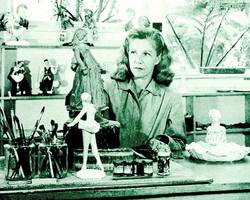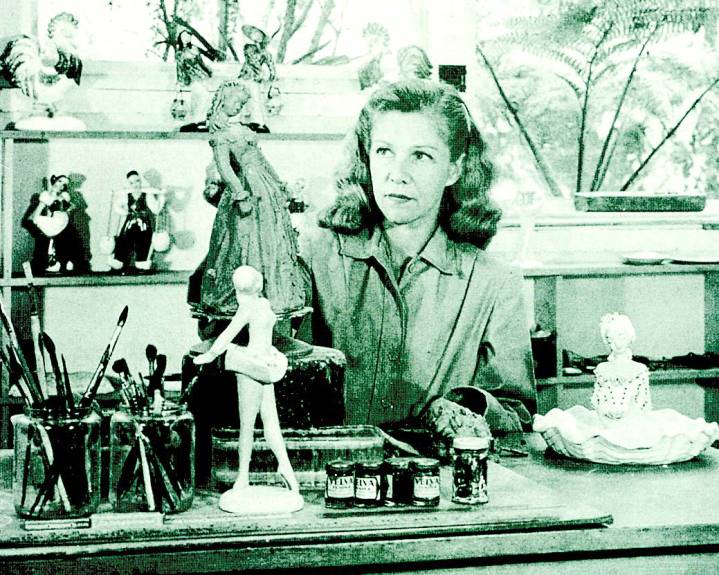Born Hedwig Schoop to a prominent family in Zurich, Switzerland, her father was editor of the Neue Zurcher Zeitung and president of Dolder Hotels. She studied sculpture, architecture, painting, and fashion design at several European art institutions including Kunstgewerbeschule in Vienna and Reimann Institute in Berlin. With her sister, Trudi Schoop, she is also remembered for her work in European dance and cabaret. Fleeing the rising Nazi power, she and her husband, renowned composer and torch song writer, Friedrich Hollander, left Germany for Hollywood in 1933. In her new environment, she became an innovator of mid-century California pottery design, and became perhaps the most commercially successful California ceramics designer of the postwar period, and certainly the most ubiquitous. If a Schoop figure proved popular with consumers, an entire line of accompanying décor objects, such as planters, bowls, ashtrays, and candy dishes, and lamps would be built around it. At its busiest in the late 1940s, the studio produced over 30,000 giftware items per year, and employed over fifty workers. The factory was destroyed by fire in 1958, and shortly after that Schoop retired from ceramic design, focusing instead on painting.
In 1943 Hedi Schoop married Ernst Verebes, talented in his own right as a famous actor in European film, and with whom she had a son, Anthony Verebes. The son survives, and is a prominent Los Angeles photographer.
Born Hedwig Schoop to a prominent family in Zurich, Switzerland, her father was editor of the Neue Zurcher Zeitung and president of Dolder Hotels. She studied sculpture, architecture, painting, and fashion design at several European art institutions including Kunstgewerbeschule in Vienna and Reimann Institute in Berlin. With her sister, Trudi Schoop, she is also remembered for her work in European dance and cabaret. Fleeing the rising Nazi power, she and her husband, renowned composer and torch song writer, Friedrich Hollander, left Germany for Hollywood in 1933. In her new environment, she became an innovator of mid-century California pottery design, and became perhaps the most commercially successful California ceramics designer of the postwar period, and certainly the most ubiquitous. If a Schoop figure proved popular with consumers, an entire line of accompanying décor objects, such as planters, bowls, ashtrays, and candy dishes, and lamps would be built around it. At its busiest in the late 1940s, the studio produced over 30,000 giftware items per year, and employed over fifty workers. The factory was destroyed by fire in 1958, and shortly after that Schoop retired from ceramic design, focusing instead on painting.
In 1943 Hedi Schoop married Ernst Verebes, talented in his own right as a famous actor in European film, and with whom she had a son, Anthony Verebes. The son survives, and is a prominent Los Angeles photographer.
Family Members
Sponsored by Ancestry
Advertisement
Records on Ancestry
Advertisement





